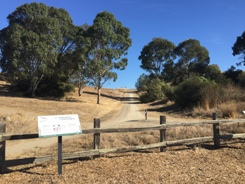By Diana Stark
 Menlo Park is taking an innovative approach to reducing the use of herbicides and pesticides in parks and on city property. It’s also banning rodent poisons and conducting a study of herbicide- and pesticide-free management of four parks in 2016.
Menlo Park is taking an innovative approach to reducing the use of herbicides and pesticides in parks and on city property. It’s also banning rodent poisons and conducting a study of herbicide- and pesticide-free management of four parks in 2016.
The City of Menlo Park recently undertook several innovative steps to limit the use of herbicides and pesticides on city property to control runoff into bodies of water and to cut potential exposure of citizens, wildlife and maintenance workers. These actions include an updated Integrated Pest Management Policy that greatly reduces herbicide and pesticide use and bans rodent poison, a one-year trial of herbicide-free management of four city parks, and a call for proposals to make all city parks herbicide-free.
In August, the city council passed an Integrated Pest Management Policy to address county and local water pollution requirements and community concerns about potential toxins in the insecticides, rodenticides and weed killers used in the city. The policy was an update to an existing 1998 pest management policy.
The updated IPM policy outlines uses of biological control, habitat manipulation, modification of cultural practices and pest-resistant plantings to reduce pests and their damage. Mulching and mowing, the use of natural predators, grazing, and traps, barriers and removal by hand are all practices emphasized in the new policy to replace herbicide/pesticide use. Chemical products would only be used in specific situations where other methods have failed, and then the least toxic products would be prioritized and notice would be posted at the treatment location.
The new policy specifically bans poison rodent bait products in favor of traps and barriers. This will reduce not only the poison in the traps, but also instances of poisoned rodents spreading the toxins to wildlife, birds or pets that may consume them.
The city council’s action also banned the following pesticides that impact non-target organisms and water quality: neonicotinoids (considered to be especially harmful to bees and pollinators); organophoshates; Pyrethroid; Carbaryl; and Fipronil.
Before passing its updated IPM policy, the city conducted an experiment comparing several strategies to the previous maintenance practices using pesticides and herbicides. The main finding was that non-herbicide procedures would require the maintenance crew to spend more time on the “hands on” activities such as mowing, mulching, and pest management tasks. To study this issue further, the city council also approved a proposal at the August meeting to enter into a contract for herbicide-free maintenance of four parks – Bedwell Bayfront, Fremont, Willow Oaks and Stanford Hills – for one year. The cost of this program is not to exceed $86,000. The pilot program will begin in January. When completed, the city will evaluate whether weed control was achieved on various landscapes and the cost.
The council also voted to issue a Request for Proposal to gather potential plans to convert all city parks to herbicide free zones, if the pilot is successful.
“We’re very excited to try this innovative approach,” said Heather Abrams, environmental programs manager for the Public Works Department of the City of Menlo Park.
Mayor Catherine Carlton also sponsored a resolution encouraging the public to follow the city’s lead on their private properties. You can read the resolution here.
For further information about the new Integrated Pest Management Policy and the actions taken by the city council at the August meeting, read the report here.
Diana Stark’s yard is free of synthetic herbicides and pesticides. Compost and mulch are used and native plants are being gradually added (including milkweed for Monarch butterflies). Birds are abundant and pollinators thrive!